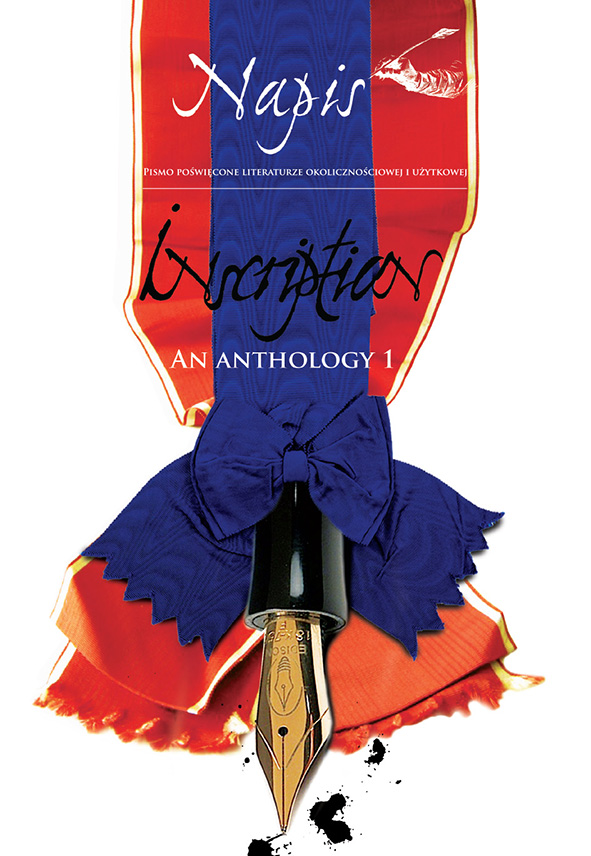Journal issue no.
Inscripton. An Anthology 1
Editors of "Inscription. Journal devoted to occasional and applied literature" is pleased to announce the online publication of the first part of the English-language translation series "Inscription. An anthology 1” – a selection of 13 articles from among 535 dissertations published in the yearbook in the years 1994–2021. They can be found on the pages of the Digital Repository of Scientific Institutes and "Inscription".
The first special issue is necessarily only a small fraction of the journal's output, but it shows both its multilateralism and the growing of humanistic knowledge and methodological awareness within occasional and applied literature.
Our literary and cultural studies yearbook "Inscription. A journal devoted to occasional and applied literature" was created in the environment of researchers of Polish nobility culture of the end of the 18th century, gathered around Prof. Janusz Maciejewski (1930-2011), and dealing with editorial and textological works on occasional literature from the times of the Bar Confederation (1768-1772), the multivolume edition of which finally saw the light of day in the years 2005-2008.1 However, much earlier, in 1975, Professor Maciejewski published an article in the renowned literary studies magazine "Teksty" ("Texts" – journal of the Institute of Literary Research of the Polish Academy of Sciences), entitled “Obszary trzecie literatury” [Third areas of literature], in which he defined the scope of his research school’s interests as literary texts distinct from fine literature in the strict sense and outside of folklore (directly related to folk culture). Among the literary genres and forms of writing that fall within the research field thus defined, Prof. Maciejewski mentioned among others: inscriptions, epigrams, epitaphs, minstrel’s comedy, bourgeois poetry and epigram, letter, folk songs and songs of itinerant singers, satires and lampoons, political poetry of various historical periods. These forms of writing existed in many literary traditions of various nations, but it was only in the Old Polish tradition that such a literary genre as the gentry’s tale appeared, which was associated with a specific form of socio-political organization of the then Republic of Poland (noble democracy) and its historical fate, and at the same time was a model example of occasional and applied literature. Another form that undoubtedly belongs to the ‘third areas of literature’ is the worker’s poetry, created spontaneously under the influence of the current situation during the political breakthrough in Poland in 1980–1981, which led to events symbolically referred to collectively as the ‘fall of communism’. This compilation defines an indicative framework (both chronological and genre) of the method of research approach to occasional and applied literature which is promoted by the Napis [Inscription] yearbook. This method refers, on the one hand, to the new achievements of the theory of literature, anthropology and sociology, and on the other, to the specific experiences of Polish society, which for decades after the loss of sovereignty relied on literature as not only a source of comments on current events (in the absence of political representation and independent press), but also as a social ‘glue’ that sustains collective identity and the active pursuit of freedom.
From the Introduction by Marek Pąkciński
List of contents
Marek Pąkciński, Introduction: Literature: text and social communication; Janusz Maciejewski, Occasional and applied literature. (In place of an introduction); Aleksander W. Lipatow, Russia and Poland – a ‘domestic row’ of Slavs, or a conflict of mentalities?; Beata Cieszyńska, The image of Poland and Poles in the Dmitriads, from the British perspective; Barbara Wolska, Without guilt or shame. Sexuality in eroticism-themed Polish obscene poetry of the Enlightenment period; Dorota Samborska-Kukuć, Resident bards. The court poet in light of memories from the Polish Eastern Borderlands in the first half of the 19th century; Agata Grabowska-Kuniczuk, A ‘judgement of the eye’? The way(s) the world is perceived in Bolesław Prus’s prose works; Jolanta Sztachelska, From a trip East. On a different Europe and the genre-fluid nature of the letter in Henryk Sienkiewicz’s travel correspondence; Marek Pacukiewicz, ‘A different fabric’. The overt and the hidden in Joseph Conrad’s prefaces to his prose works; Wiesław Ratajczak, Conrad and Arendt. Revealing the roots of evil; Agnieszka Bąbel; The art of breaking up. Infelicitous engagements in Polish novels and memoirs from the turn of the 20th century; Marek Pąkciński, Body, gender, and a communist’s shame (side notes on Stanisław Lem’s utopian science fiction novels from the 1950’s); Franciszek Apanowicz, The issue of the genre of Kolyma stories by Varlam Shalamov and its editions in Polish; Aleksandra Matykiewicz-Włodarska, The Luther effect. The consequences of the Reformation in the area of printed media and communication.
Information
Recently added issues
Napis. Pismo poświęcone literaturze okolicznościowej i użytkowej | | 2025
Napis. Pismo poświęcone literaturze okolicznościowej i użytkowej | | 2024
Napis. Pismo poświęcone literaturze okolicznościowej i użytkowej | | 2024
Napis. Pismo poświęcone literaturze okolicznościowej i użytkowej | XXIX | 2023
See also
Napis. Pismo poświęcone literaturze okolicznościowej i użytkowej | | 2024
Journal issue title: Inscription. An Anthology 2
On the website of the yearbook ‘Inscription. Periodical on Occasional and Applied Literature' (https://napis.edu.pl/2024-special-issue/) a new special issue is available – a continuation of the selection ‘Inscription. An Anthology 1'.
Napis. Pismo poświęcone literaturze okolicznościowej i użytkowej | | 2024
Journal issue title: Inscription.Periodical on Occasional and Applied Literature
We are happy to announce, that on the website of the yearbook ”Inscription. Periodical on Occasional and Applied Literature” (https://napis.edu.pl/en/2024/) the new, 30th anniversary issue of “Napis” (“Inscription”) has been published. The issue “Crumbs of testimony. Inscriptions, initials, glosses in culture” focuses on intriguing testimonies of the past in literary and social communication, such as inscriptions, dedications, epigraphs, which take the form of gravestone inscriptions, graffiti or memes.
European Journal of Life Writing | (10) | 2021
Journal issue title: Cluster on “Remembering Late Socialism in Autobiographical Novels and Autofictions from Central and Eastern Europe”
